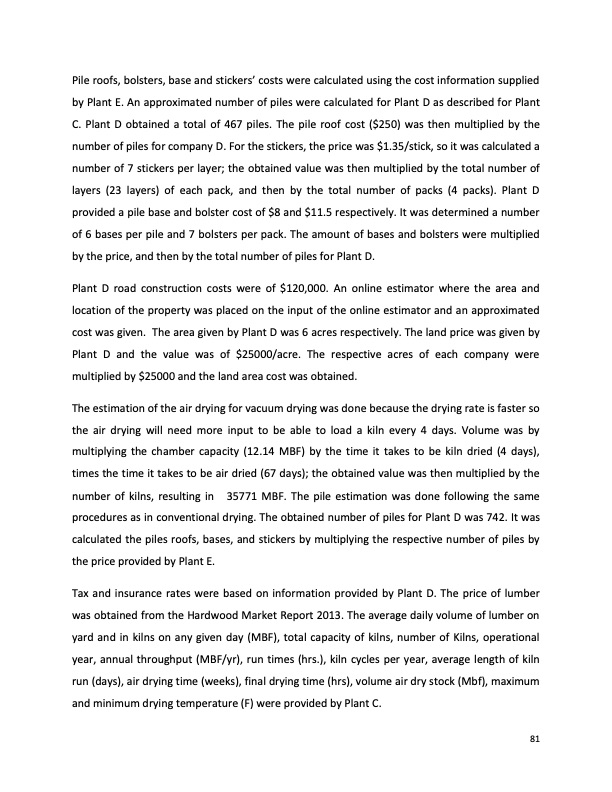
PDF Publication Title:
Text from PDF Page: 091
Pile roofs, bolsters, base and stickers’ costs were calculated using the cost information supplied by Plant E. An approximated number of piles were calculated for Plant D as described for Plant C. Plant D obtained a total of 467 piles. The pile roof cost ($250) was then multiplied by the number of piles for company D. For the stickers, the price was $1.35/stick, so it was calculated a number of 7 stickers per layer; the obtained value was then multiplied by the total number of layers (23 layers) of each pack, and then by the total number of packs (4 packs). Plant D provided a pile base and bolster cost of $8 and $11.5 respectively. It was determined a number of 6 bases per pile and 7 bolsters per pack. The amount of bases and bolsters were multiplied by the price, and then by the total number of piles for Plant D. Plant D road construction costs were of $120,000. An online estimator where the area and location of the property was placed on the input of the online estimator and an approximated cost was given. The area given by Plant D was 6 acres respectively. The land price was given by Plant D and the value was of $25000/acre. The respective acres of each company were multiplied by $25000 and the land area cost was obtained. The estimation of the air drying for vacuum drying was done because the drying rate is faster so the air drying will need more input to be able to load a kiln every 4 days. Volume was by multiplying the chamber capacity (12.14 MBF) by the time it takes to be kiln dried (4 days), times the time it takes to be air dried (67 days); the obtained value was then multiplied by the number of kilns, resulting in 35771 MBF. The pile estimation was done following the same procedures as in conventional drying. The obtained number of piles for Plant D was 742. It was calculated the piles roofs, bases, and stickers by multiplying the respective number of piles by the price provided by Plant E. Tax and insurance rates were based on information provided by Plant D. The price of lumber was obtained from the Hardwood Market Report 2013. The average daily volume of lumber on yard and in kilns on any given day (MBF), total capacity of kilns, number of Kilns, operational year, annual throughput (MBF/yr), run times (hrs.), kiln cycles per year, average length of kiln run (days), air drying time (weeks), final drying time (hrs), volume air dry stock (Mbf), maximum and minimum drying temperature (F) were provided by Plant C. 81PDF Image | Impact of Vacuum-Drying on Efficiency of Hardwood Products

PDF Search Title:
Impact of Vacuum-Drying on Efficiency of Hardwood ProductsOriginal File Name Searched:
Brenes_Angulo_OM_T_2014.pdfDIY PDF Search: Google It | Yahoo | Bing
5,000 BF Shipping Container Lumber Dry Kiln For Quality Lumber The 5,000 BF container kiln consists of one 40 foot high-cube aluminum shipping container... More Info
Shipping Container Lumber Dry Kilns by Global Energy Global Energy designed and developed the container kiln back in 1991. The purpose is to give access to portable sawmill owners, furniture makers, and small business the value added profit of dry kiln lumber and quality hardwoods... More Info
Vacuum Kiln Conversion Kit for Lumber and Wood Dry Kilns Convert your existing conventional dry kiln into a fast drying vacuum kiln. Similar to vacuum bagging in the boat building and aircraft industry, we have come up with a proprietary process which allows you to build a very simple vacuum kiln at a fraction of the price, and without the intensive conventional metal chamber structure... More Info
Vacuum Pump Cart System for Bagging Clamping Wood Drying and more Vacuum Cart with 2HP Pump and Dual Pistons with multiple multiplex vacuum ports and liquid reservoir... More Info
Vacuum Bagging Basics Vacuum bagging is a method of clamping, which has traditionally been used in the composites industry, but can also be used for vacuum drying materials, including wood products... More Info
| CONTACT TEL: 608-238-6001 Email: greg@globalmicroturbine.com | RSS | AMP |